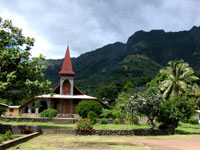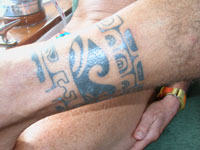| 2C Update #109
Île Tahuata
Vaitahu Bay
May 7-9
The island of Tahuata is the one that figures most prominently in the early days of the Marquesas interaction with Europeans. It was at Vaitahu on Tahuata where Alvaro Mendaña de Neira first went ashore in 1595, and also at Vaitahu where Captain James Cook returned on Resolution in1774. A monument in front of the post office reminds visitors that the islanders' own name for these islands is Fenua Enata or
'the land of men'. Interestingly, most of the other monuments in town are to French soldiers, fallen here in the fight to conquer them.
After a week of R&R&R (that's rest, recreation and repairs) in Hanamoenoa, a very lovely anchorage but one that could have been anywhere, we motored the few miles south to the village of Vaitahu, the largest of four villages on the island and there found our first, real Marquesan experience. So near in miles, Vaitahu was extremely different in appearance from Hanamoenoa. Instead of white sand, the shoreline was dark, with rocky, chocolate sands in front of the village and dark cliffs forming the sides. The water, too, was dark, thanks to a bottom that drops away sharply from the anchoring shelf. On all three sides, the terrain above was precipitous but green, grasses on the flanks, trees in the ravines. We saw goats scattered across the hillside, notched into crevices. Above all this the island's peak thrust up into ever-present cloud.
We were one of three boats in the anchorage, a French boat far to starboard and we and our good friends Mike and Mary of Danseuse de la Mer, snugged up together on the left. We all got ashore by taking T2's dinghy to the stone quay and anchoring it off bow and stern because de la Mer's four-stroke Honda wouldn't start. From the quay it was an easy walk to the village center built on the small bit of flat land behind the beach. The town's centerpiece is its large, somewhat modern church, built in a hexagonal (octagonal? I didn't count) plan with river stones and wood with a lovely stained glass window of the Mary and the infant Jesus above.
 |
 |
As lovely as the church was, it wasn't what motivated us to come here. What actually motivated us to come initially was curiosity about its tattoo artist. The Marquesans were once known for their all-over body tattoos, although it (like cannibalism) died out under church repression. However (unlike cannibalism) tattoo artistry is experiencing a big comeback, probably thanks to its comeback in the western world Almost all the men and even a lot of the women we've see in the Marquesas have some kind of tattoos. Most of the men's tattoos seem to follow the traditional designs, taking up great spaces on arms, back or legs, while a lot of the women have tattooed ornamentation just under their ears!
When Dennis of Bobulona motored back into Hanamoenoa to help us with the rig repair, he arrived from Vaitahu sporting a very large (about 8 inches tall) traditional tattoo encircling his lower calf! We were--ah--impressed, and yes stunned. We'd thought Dennis to be a fairly traditional guy, and indeed he admitted to the tattoo having been a spontaneous thing. Or at least as spontaneous as about six hours can be!
Now Don has always had a secret fantasy about getting some sort of traditional tattoo when he finally reached the South Pacific isles. Something, perhaps, little smaller than Dennis's, however, and I don't think he thought it would come up so soon. But we were all curious, and so we found ourselves in Vaitahu.
You can relax, Grandma, the guy wasn't in. Well, actually, he was, only we didn't get around to asking for him right off and his whereabouts wasn't obvious. On our way back to the boat we ran into some other cruisers who'd dinghied down from Hanamoena, and one showed off his new tattoo. Actually, this one was a lot more like it. Much smaller, it was a realistic turtle with a Marquesan-type patterns for the shell with a face looking out. The turtle pointed out the problem with
'our' expectations. We liked the realistic image better, but it wasn't a traditional design. The traditional designs for many familiar things like turtles, dolphins, whales, rays and tropic birds, don't look remotely like the real things! Then, after stewing on it all night and going back the next day to look into it a little further--then the guy wasn't there. Probably a relief to everybody.
Instead we wandered the roads and struck up conversations with several different people. The first was Georges, a man we found sitting bare-chested on a wall in front of his house. He took us to meet Robert, an outboard mechanic, who would come the next day to take a look at de la Mer's non-functioning outboard. On our way back downhill, we encountered Richard, a youngish man engaged in building a traditional style house out of bamboo and thatch. Most of the residents of town live in pseudo-western style homes of concrete with galvanized roofs. Richard was retro and clearly an artist. He had recently finished an outdoor wash area with a whimsical basin of stones in the shape of a giant mouse. The wash area, kitchen and eating areas were all separate and outside the tiny sleeping hut, and already in place were several artistically fashioned planters with decorative plants.
The next morning, on our hunt for Robert (who hadn't shown up as scheduled) we met Celeste. Celeste, whose house is at the top of the road, is clearly a man of means. He had a truck and a boat in his yard, and through the doors to his living room we could see brightly upholstered couches. Indeed we eventually put together that he was the
'employer' for whom many of the men in town-- Robert, Richard and probably Felix, the tattoo guy-- were all off in the mountains picking nonni. Nonni is a lumpy, ugly fruit that has become the second big cash crop for these islands along with copra. The nonni fruits are fermented in barrels and shipped to Papeéte, where it is crushed into juice and then shipped to the State for
'medicine' !?!?! (We have had no luck in determining exactly what
'medicine' nonni is a component of?) Celeste was batching it while his wife was in Papeéte for a nonni convention, and he spent lots of time chatting with us and loading us high with local fruits.
 This is as good a time as any to talk about pamplemousse. Pamplemousse is the French word for grapefruit, but it is much more of a word, and so much more of a fruit than grapefruit. Pamplemousse are huge fruit, almost the size of a cantaloupe, with a greenish yellow skin, and they are sweeter than the best grapefruit you have ever had. The locals are justly proud of them, and they give them to you as the best of gifts. They are received in the same manner. Bananas here, on the other hand, are about half the size of the ones back home, but they too are just a bit better being fresh from the stalk. There are also oranges, limes, and mangos, which have been okay but haven't yet measured up to their California , Mexican and Caribbean cousins. Then again, beggars oughtn't to be choosy, and that's essentially what we cruisers are with respect to fruit?beggars. You can't buy it, because everybody has it. This is as good a time as any to talk about pamplemousse. Pamplemousse is the French word for grapefruit, but it is much more of a word, and so much more of a fruit than grapefruit. Pamplemousse are huge fruit, almost the size of a cantaloupe, with a greenish yellow skin, and they are sweeter than the best grapefruit you have ever had. The locals are justly proud of them, and they give them to you as the best of gifts. They are received in the same manner. Bananas here, on the other hand, are about half the size of the ones back home, but they too are just a bit better being fresh from the stalk. There are also oranges, limes, and mangos, which have been okay but haven't yet measured up to their California , Mexican and Caribbean cousins. Then again, beggars oughtn't to be choosy, and that's essentially what we cruisers are with respect to fruit?beggars. You can't buy it, because everybody has it.
Robert did, in fact, show up after the nonni outing to take a look at de la Mer's outboard. I had feared he'd be totally stumped by the four-stroke motor that ecologically-minded California has required of its constituents. But the problem was not in the motor per se, but in the electrical system-- no
'courant'-- which of course involves the same kind of proprietary (and therefore unavailable) power pack that used to plague us on our old Johnson. Never go cruising with anything but a Yamaha. We say so, and Robert says so.
Speaking of outboards, it is interesting to see how outboards and outrigger canoes come together. Essentially, the outboard rides side-saddle on the strut for the outrigger!
For our last evening in Vaitahu we went ashore to watch Robert in the evening bocci ball tournament. This is, evidently, an every night thing, and the
'tree' (pairings ladder) was posted on a building wall. Down the road, in front of the church, the youngsters played volleyball. When the sun set, the town folded up, so we went home just as the mists rolled down from the mountain for a gentle, steady all-night rain. |